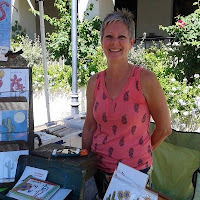- I described my 40+ years of experience, education and training in community development.
- I expressed the "why" I believe it's important to build better for us communities who value and enhance
- happiness
- health and well-being
- and creative capital for all members.
 |
| Anita Fonte at UA Tucson Village Farm, harvesting season 2015 |
Is the community that you, the reader lives in ready and willing to not only measure Gross Domestic Product (GDP), but also Gross Happiness Product (GHP)? Is the community you live in ready and willing to promote happiness, health and well-being for all its members? Is the community you live in ready and willing to focus on generating incentives for creative people to work in your community? And are you willing to do what you can to "make it so"?
Every small step helps--just thinking about what I have shared in this short, and incomplete, selection of photos and words may be the tipping point for positive change in your life and community. Let's try to work together to make our communities better for us.
I will continue to work on my ebook and plan to offer it for free early next year. Also, in March and April, 2016, there will be opportunities for community members to learn about several of the tools mentioned in my blog as well as other resources that can help build communities better for us.
And, before I sign off for now, here's a short list (as Austin Kleon demonstrates in Show Your Work!) of the books and resources that helped make this blog-to-book.
Richard Florida. The Rise of the Creative Class (2002)
Richard Harwood. Make Hope Real (2007)
Gallup-Healthways. Well-Being Index www.well-beingindex.com
Austin Kleon. Show Your Work! (2014)
OECD. How's Life? 2015 (2014) www.oecd.org
State of the States www.gallup.com/poll/125066/state-states
The Well-being Project Summary Findings (2015) http://wellbeing.smgov.net/projectresources
Jean Twenge. "Young People are Happier than they Used to Be..." The Atlantic Health (2015) www.thatlantic.com/author/jean-twenge














































